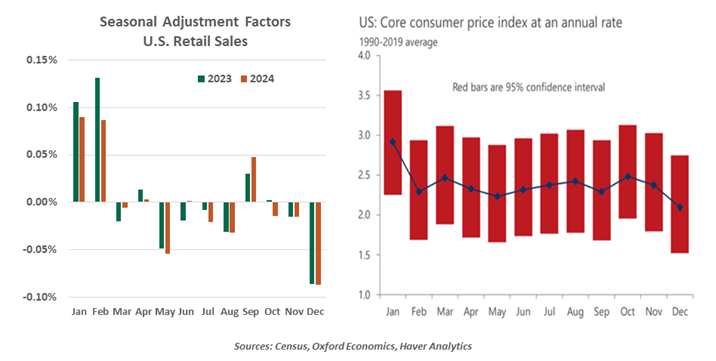by Carl R. Tannenbaum, Chief Economist, Northern Trust
Seasonal adjustments have limitations.
At this time of year, those of us who live in the Northern hemisphere are looking forward to a change of season. Statistically, every February week in Chicago should see the daily high temperature rise by 2-3 degrees Fahrenheit, but conditions can vary significantly from expectations.
Economists are very familiar with seasonal trends in data. But even adjusting for them, some recent U.S. readings have varied significantly from expectations. This may have been caused by elements of seasonality that go beyond what is captured by government agencies.
Seasonal factors can often muddy economic readings.
A variety of calendar-based factors can cause movements in economic metrics. Weather, production schedules and holidays all play a role. Statisticians attempt to adjust for these, so that trends over time can be more clearly discerned.
A good example is reporting on retail sales. Purchasing typically crests as Christmas approaches, and falls off substantially in January. To make the series comparable from month to month, readings at the beginning of the year are lifted, and those at the end of the year are diminished.

Even in the presence of this kind of smoothing, some “residual seasonality” may be evident. As shown in the chart above, January readings on U.S. consumer prices have been persistently higher over the last 30 years. This can result from the implementation of annual price increases, new labor contracts, or vendor arrangements. The statistical techniques used to detect month-to-month variations do not deal well with these factors.
As a final thought, seasons don’t progress the same way each year, either climatically or economically. Adjustments are usually based on a trailing history, around which there can be considerable variation.
Observers are always anxious for the most proximate news, but the noise that surrounds monthly data can raise the risk of overreaction. We always recommend looking at information over longer time spans, which limits the influence of periodic abnormalities.
Much as we might try to insulate ourselves against the extremes of seasons, conditions have a way of breaking through our controls. To wit: I am not planning on putting away my heavy winter coat until June 1.
Copyright © Northern Trust















